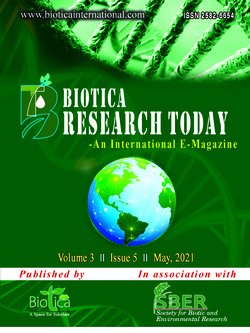
Water Hyacinth - Effective Remediation for Heavy Metal Pollution
Aswathy S. Nair*
State Emergency Operation Centre, Kerala State Disaster Management Authority, Kerala (695 033), India
Durga C.
Dept. of Agronomy, Kerala Agriculture University, Vellanikkara, Thrissur, Kerala (680 656), India
Vaisznavi B.
Dept. of Agricultural Biotechnology, TIAC, Tirunelveli, Tamil Nadu (627 001), India
DOI: NIL
Keywords: Compost, Metal binding sites, Water hyacinth, Water pollution
Abstract
Water hyacinth (Eichhornia Crassipes) is a fast-growing aquatic plant considered as a weed when growth is not controlled. Heavy metal pollution in water bodies is increasing at alarming rate, reducing the quality of water bodies. Water hyacinth is typical example for hyper accumulators of heavy metals. Research studies shows that Eichhornia crassipes was able to accumulate chromium in its shoots at 223 times and zinc at 134 times than the concentration in the water. The presence of potential metal sites mainly on stems and roots makes the hyacinth a good tool for heavy metal extraction. The microorganisms associated with roots helps to do the transition of heavy metals by producing enzymes. It is not advisable to use the water hyacinth for compost making if it’s growing in contaminated water bodies.
Downloads
not found
Reference
Metcalf, L., Eddy, H.P., 1916. American Sewerage Practice. Disposal of Sewage, McGraw-Hill Book Company Vol 3, p. 187.
Pravin, U., Ravindra, M., Manisha, P., Deepak, V., 2012. Aquatic pollution in Mithi River of Mumbai: assessment of physico-chemical parameters. Interdisciplinary Environmental Review 13(4), 245–268.
Upadhyay., Alka, R., Tripathi, B.D., 2007. Principle and Process of Biofiltration of Cd, Cr, Co, Ni & Pb from Tropical Opencast Coalmine Effluent. Water, Air, & Soil Pollution, Springer 180(1-4), 213–223.
